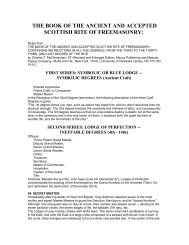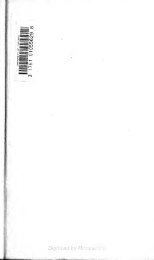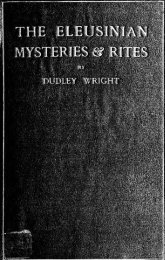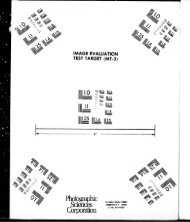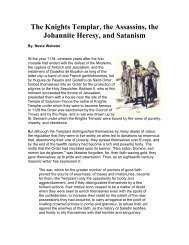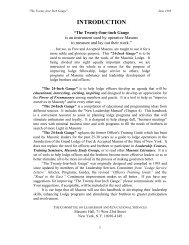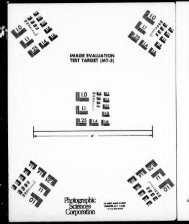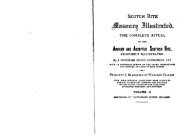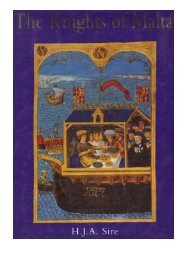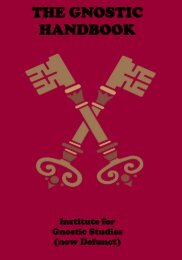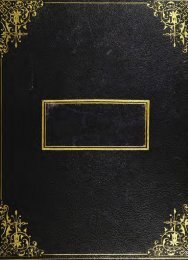The History of Initiation - The Masonic Trowel
The History of Initiation - The Masonic Trowel
The History of Initiation - The Masonic Trowel
Create successful ePaper yourself
Turn your PDF publications into a flip-book with our unique Google optimized e-Paper software.
IN PERSIA. 75<br />
displayed to his view by the divine lighfs 01 in this vast<br />
and diversified cavern, 92<br />
incident which excited his<br />
every<br />
every transaction in life, how trivial soever. I subjoin an enumeration<br />
<strong>of</strong> many <strong>of</strong> them from Richardson. "<br />
(Dissert., p. 275.) Nushret<br />
was an amulet for preventing or curing insanity, or other malady.<br />
Keble, a philtre by which necromancers pretended to reconcile enemies.<br />
Ghezshghaw were tufts made <strong>of</strong> the hair <strong>of</strong> sea-cows, and<br />
hung round the necks <strong>of</strong> horses to defend them from fascination.<br />
Shebarik, a tree <strong>of</strong> which they make amulets for the same purpose.<br />
Azimet, an amulet, incantation, or spell against serpents, disease, or<br />
other evil. Sulwanet, shells, rings, or beads used as amulets. Sulwan<br />
denotes water taken from the grave <strong>of</strong> a dead man, poured from<br />
a kind <strong>of</strong> shell upon the earth, which they drink to the health <strong>of</strong> a person<br />
as a cure for love, or any severe affliction. Atfet or Antefet, small<br />
beads hung by women round their necks, as a charm to gain the affection<br />
<strong>of</strong> lovers. Akret, a spherical amulet worn by some women round<br />
their waists to prevent pregnancy; and by others to favour a conception.<br />
Akhzet, an amulet in form <strong>of</strong> a knot, which women wear to<br />
keep their husbands faithful. Nirenk, nirek, hemail tawiz, mikad,<br />
mutemmim, gezz, kherez, kehal, wejihet, rab, kyrzehlct, mawiz, berim,<br />
signify amulets made <strong>of</strong> shells, beads, tufts <strong>of</strong> wool or dead<br />
hair^<br />
men's bones, &c. Neju, ferhest,<br />
reki, shuh, latet, nezret, %c., imply<br />
fascination or malignant eyes. Kherchare -is an ass's head placed on<br />
a pole in a garden, &c., to guard against fascination. Bazur and<br />
bazubend signify amulets or any kind <strong>of</strong> ligatures used in enchant-<br />
ment, because they are in general fastened round the arm, which the<br />
latter word implies. Cheshm benam, an amulet for averting the fascination<br />
<strong>of</strong> malignant eyes." Thus far Richardson, but I beg leave<br />
to quote a very curious passage on this subject from Odoricus, in Hak-<br />
luyt, cited by Southey, in his fine poem <strong>of</strong> Thalaba, (vol. i., p. 114,)<br />
although the note is already somewhat too much extended. " In the<br />
country called Panten or Tathalamasin, there be canes called Cassan,<br />
which overspread the earth like grasse, and out <strong>of</strong> every knot <strong>of</strong><br />
them spring foorthe certaine branches, which are continued upon the<br />
ground almost for the space <strong>of</strong> a mile. In the sayd canes there are<br />
found certaine stones, one <strong>of</strong> which stones whosoever carryeth about<br />
with him, cannot be wounded with any yron; and therefore the men<br />
<strong>of</strong> that country, for the most part, carry such stones with them,<br />
whithersoever they goe. Many also cause one <strong>of</strong> the armes <strong>of</strong> their<br />
children while they are young, to be launced, putting one <strong>of</strong> the<br />
sayd stones into the wound, healing also and closing up the sayd<br />
wound with the powder <strong>of</strong> a certain fish, (the name where<strong>of</strong> I do not<br />
know,) which powder doth immediately consolidate and cure the sayd<br />
wound. And by the vertue <strong>of</strong> these stones, the people aforesaid doe,<br />
for the most part, triumph both on sea and land."<br />
91 This display was denominated Zvroyia, as we learn from Psellus<br />
in his Notes on the Oracles <strong>of</strong> Zoroaster.<br />
9-2 He was taught the hieroglyphical character, or sacred cipher, in<br />
which their mysterious dogmata were perpetuated; specimens <strong>of</strong><br />
which, according to SirW. Jones, (Asiat. Res., vol. ii., p. 57,) still<br />
remain.



